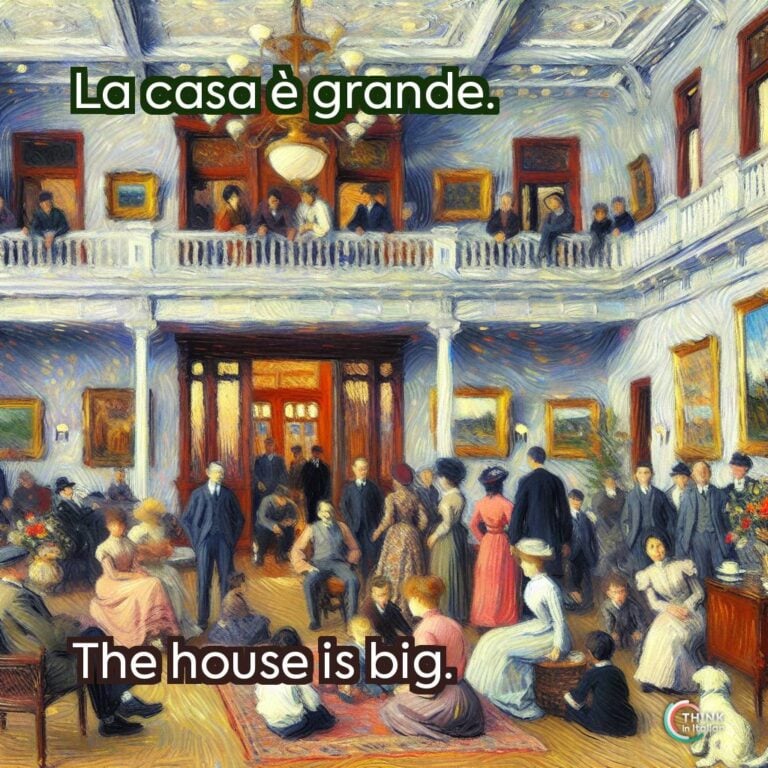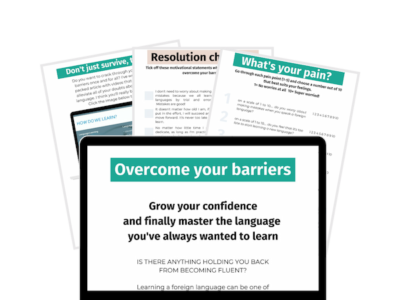Download The List
In a hurry? Download a PDF with all the words!
Or else, learn more about the list and the most common terms that you’ll find on it.
Top 1,000 Most Common Italian Words
Whenever I start learning a new language, my main aim in the very beginning is to grasp the basics swiftly. Efficiency is always the key!
What I find particularly useful are lists of the most common words, so here you are a detailed overview of the 1,000 most common Italian words.
These are the words that will carry you through the majority of conversations, allowing you to navigate daily life and simple conversations. Trust me, it will be a game changer!
Core Vocabulary: What to Know
Verbs, Nouns, and Adjectives
The top 1,000 most common words in Italian include essential verbs like fare (to do/make) and essere (to be), nouns like “casa” (house) and tempo (time), and adjectives like buono (good) and bello (beautiful).
Knowing these words gives you the building blocks to smoothly string sentences together like a native speaker.
Connectives and Adverbs
Connectives and adverbs like perché (because/why), quando (when), and anche (also) serve as connectors. They help you link sentences together, connecting ideas and clarifying your point. Mastering these words makes your sentences sound more natural.
Common Expressions and Their Context
One of my favorite expressions is magari, which means “maybe” or “I wish”. I love how it can convey both hope and uncertainty, like:
magari potessi andare in vacanza quest’anno!
I wish I could go on vacation this year!
Understanding these nuances makes a big difference in everyday conversations.
How to Incorporate Them Into Your Studies
Flashcards: the Utility

Now that I have shown you the benefits of focusing on the common words, let’s go over the methods to memorize them.
When I was learning Russian, I practiced with flashcards. I used to pair each Russian word with its Italian equivalent.
This technique made it easier to remember the words while learning their translations. But beyond that, the real trick is immersion: try to use these words in sentences daily!
You can create your own flashcards, either on paper, on websites, or apps like Anki, Memrise, and Quizlet.
- Anki is fairly popular in the language learning community. You can use it to create your flashcards and its function goes beyond language learning. The user interface is not the most modern, but it gets the job done.
- Memrise has a more friendly user interface for creating and reading digital flashcards. My favorite part about Memrise is the ability to leverage the other digital flashcards that other community members have created.
- Besides flashcards, Quizlet offers practice quizzes and interactive learning games. It allows users to create custom study sets or access others’ ones. The platform is popular for its retention enhancement through spaced repetition.
Flashcards: the Problems
Even though flashcards can be useful for learning the most common words in Italian, they no longer are my favorite option.
I admit it: I used to study through flashcards during my bachelor’s, but then I entered my master’s and I learned a lot more about how the human brain works for retaining new vocabulary.
Learning new words in Italian through flashcards is useful if you are facing the Italian language for the very first time, but it might be less effective for three main reasons:
- Lack of Context: Flashcards typically present words without their contextual surroundings.
For instance, learning the word penna alone doesn’t clarify if it refers to a pen, a feather, or a plectrum, but it is essential to learn words in context.
Without seeing how words interact with others in sentences, learners may find it hard to understand their accurate use in conversation.
- Surface Learning: Flashcards focus on memorizing definitions, which often leads to surface-level understanding.
If you memorize the verb passare as “to pass”, you might not differentiate its meanings in phrases like passare da qualcuno (to stop at someone’s place), passare l’esame (to pass the exam), or passare il sale (to pass the salt).
The emphasis on mere memorization doesn’t encourage learners to deeply engage with the word’s various connotations and uses.
- Repetition Fatigue: Flashcards rely on repetitive practice, which can become monotonous over time.
This repetitiveness may reduce the quality of retention, leading to reduced motivation as well.
Despite these cons, flashcards can be effective when used in combination with other techniques, like reading texts, practicing conversations with native speakers or AI tutors, or using words in writing.
How many Italian Words do I Need to Know?
Italian Vocabulary: Numbers and Facts
The Italian language is estimated to be made out of a total of 450,000 words with the largest Italian dictionary having over 270,000 words.
This can seem a really big and frightening number to someone wanting to start learning Italian, but here’s the good news: you only need to know roughly 5% of the total words to be fluent in Italian.
But here I am with a precious piece of advice: the most important thing is not knowing how many words to learn, but which words to know. By focusing on learning the most frequent Italian words you will be fluent in Italian in very little time.
What can I say with the 1,000 Most Common Italian Words?
This foundational vocabulary covers the essentials. You will be able to hold basic conversations about everyday topics like greetings, food, weather, and simple directions.
They cover essential words like come (as), io (I), and il suo (his), providing a foundational vocabulary for effective communication.
You might recognize up to 80-85% of the words in daily conversation, especially if native speakers speak slowly enough for you to grasp the words. However, complex topics or literature may still be challenging.
What can I say with the 2,000 Most Common Italian Words?
With 2,000 words, your ability to comprehend and discuss topics improves significantly. You can engage in deeper conversations about familiar subjects like family, work, travel, and hobbies.
At this stage, you can recognize about 90% of the words in standard conversation, which will allow you to follow most of what is said even if you don’t understand every single word.
What can I say with the 3,000 Most Common Italian Words?
Knowing 3,000 words brings you closer to fluency, allowing you to express thoughts more precisely and confidently, allowing you to handle complex topics like politics, culture, and abstract concepts.
Your comprehension reaches over 95% in most casual contexts, making it easier to pick up on nuances and idiomatic expressions. Texts and media become more accessible, and you will be able to enjoy Italian literature, news, and entertainment relatively easily.
Common Italian Words: not Only Vocabulary
Cultural Context
Language is deeply intertwined with culture, and understanding Italian vocabulary becomes much richer when we explore the cultural context that shapes the way words and phrases are used.
Take the simple word salute (health). This word is commonly used for toasting (cheers!) or to wish someone good health after they sneezed. Its use reflects the Italian emphasis on community and well-wishing, reinforcing the importance of social bonds and goodwill.
Another word is “carino”, an adaptable adjective that translates to “cute” in English, but heavily depends on context for its specific meaning. This word often describes more than physical attractiveness, since it’s also used for kindness and pleasant actions.
Understanding these cultural contexts allows learners to see the layers behind the vocabulary and use them more accurately in conversation. Words aren’t just words, they’re expressions of history, tradition, and the unique Italian worldview.
Navigating through Italian introduces you to a world rich in culture and expression. Learning Italian top common words means dedicating yourself to understanding Italian culture.
Regional Variations
Italian is the official language of Italy, but it’s also spoken by communities in Switzerland, Croatia, and elsewhere. Even within Italy, there are different dialects and regional variations that make learning this language an adventure.
Here, I want to give you an overview of how vocabulary and pronunciation can differ across regions and Italian-speaking communities:
- Switzerland (Ticino and Grisons)
In the Italian-speaking region of Switzerland, some words differ slightly from standard Italian. For instance, a mobile phone is called a natel while in Italy it’s cellulare.
- Northern Italy
In the northern regions, like Lombardy and Veneto, you might find different vocabulary.
For instance, in Milan, they use what for me is a very funny Italian word, that is schiscetta to say lunchbox, while in Venice they use the word bacaro to describe a local tavern.
- Southern Italy
Small premise: ongoing linguistic discussion revolves around whether some Italian dialects are dialects or languages. For instance, Neapolitan and Sicilian are recognized by UNESCO as separate languages rather than dialects.
In Naples, ragazzo (boy) is guaglione and testa (head) is capa, while in Sicily piedi (feet) is peri and fastidio (bother) is camurria.
It is so fun when I laugh with my Italian friends who come from other regions and I say che taglio! literally meaning “such a cut”. For me, from Rome, it means “such a fun thing!” but they never understand what I mean!
Etymology
Etymology is one of my favorite fields of linguistics! It provides a fascinating lens through which you can see the historical layers and global influences that shape the Italian language.
Learn more about the history of Italian and get a better understanding of the evolution of this beautiful language.
Exploring the etymology of some of the most common Italian words will allow you to understand their evolution and connections to other languages.
- Ciao: this famous Italian greeting comes from the Venetian phrase “s-ciào vostro”, meaning “I am your slave”. In fact, the word “s-ciào” derives from the Latin “sclavus” (slave). Over time, it was shortened to ciao and became a friendly, informal greeting meaning both “hello” and “goodbye”. The word has since been adopted by multiple languages.
- Mangiare: this verb (to eat) comes from the Latin “manducare”, which means “to chew”. Then it evolved into the different Romance languages and took the general meaning of eating.
- Libro: (book) derives from the Latin “liber”, which refers to the inner bark of a tree. In ancient times, this bark was used as a writing surface before the invention of paper. The Latin term then came to signify the concept of a book and it spread among other Romance languages as well, such as the Spanish “libro” and the French “livre”.
- Piazza: this word (square) originates from the Latin word “platea”, which means “broad street” or “open space”. The term evolved through Vulgar Latin to describe the open public squares central to Italian towns and cities.
- Zucchero: (sugar) comes from the Arabic word “sukkar”, which itself originates from the Sanskrit term “śarkarā”. Sugar made its way into European languages through Arabic traders during the Middle Ages, influencing words like sugar in English, sucre in French, and azúcar in Spanish.
The 1,000 Most Common Italian Words: a PDF for you
Let’s test if you can guess what the most common Italian words are.
Here, there is a very useful PDF with the 1,000 most common Italian words, but I also want to give you a taste of it!
| Italian | English | Italian | English | ||
| 1 | il | the (masc.) | 51 | madre | mother |
| 2 | la | the (fem.) | 52 | bambino | child |
| 3 | e | and | 53 | amico | friend (masc.) |
| 4 | in | in | 54 | amica | friend (fem.) |
| 5 | di | of | 55 | libro | book |
| 6 | a | to | 56 | acqua | water |
| 7 | che | that/which | 57 | cibo | food |
| 8 | un | a/an (masc.) | 58 | vino | wine |
| 9 | una | a/an (fem.) | 59 | mano | hand |
| 10 | per | for | 60 | piede | foot |
| 11 | con | with | 61 | occhio | eye |
| 12 | su | on/over | 62 | parola | word |
| 13 | come | like/as/how | 63 | volto | face |
| 14 | ma | but | 64 | gioco | game/play |
| 15 | più | more | 65 | strada | street |
| 16 | o | or | 66 | viaggio | journey/trip |
| 17 | da | from/by | 67 | macchina | car |
| 18 | se | if | 68 | soldato | soldier |
| 19 | perché | because/why | 69 | mare | sea |
| 20 | così | so/thus | 70 | montagna | mountain |
| 21 | molto | very/much | 71 | foresta | forest |
| 22 | tutto | everything/all | 72 | sole | sun |
| 23 | anche | also | 73 | luna | moon |
| 24 | solo | only | 74 | cielo | sky |
| 25 | bene | well | 75 | stelle | tars |
| 26 | meno | less | 76 | terra | earth |
| 27 | noi | we/us | 77 | aria | air |
| 28 | voi | you (pl.) | 78 | fuoco | fire |
| 29 | loro | they/them | 79 | luce | light |
| 30 | io | I | 80 | ombra | shadow |
| 31 | tu | you (sing.) | 81 | posto | place/spot |
| 32 | lui | he/him | 82 | cuore | heart |
| 33 | lei | she/her | 83 | capo | head |
| 34 | qui | here | 84 | spirito | spirit |
| 35 | lì | there | 85 | mente | mind |
| 36 | sempre | always | 86 | forza | strength |
| 37 | cosa | thing/what | 87 | voce | voice |
| 38 | giorno | day | 88 | canzone | song |
| 39 | notte | night | 89 | musica | music |
| 40 | casa | house | 90 | lingua | language/tongue |
| 41 | lavoro | work | 91 | nome | name |
| 42 | uomo | man | 92 | volto | face |
| 43 | donna | woman | 93 | momento | moment |
| 44 | tempo | time/weather | 94 | storia | history/story |
| 45 | ora | hour/now | 95 | verità | truth |
| 46 | anno | year | 96 | bugia | lie |
| 47 | paese | country/village | 97 | sogno | dream |
| 48 | città | city | 98 | paura | fear |
| 49 | scuola | school | 99 | sorriso | smile |
| 50 | padre | father | 100 | pianto | crying |
Of course, even though these words are frequent and useful, they don’t make any sense per se and need context to be practiced and mastered.
Whether it’s your first time approaching the Italian language, or you’re stuck at an intermediate level and want to learn faster with a focus on speaking, or you understand more than you can say, then I recommend you have a look at the free wordlist I created.
The Path to Fluency
Learning the top 1,000 Italian words is like finding the keys to a treasure chest. It opens doors to understanding the language’s rhythm and style. With these words, you can express yourself more freely and soak up the beauty of Italian conversation.
Do not forget that a language is not only words: it’s culture, grammar, and the shared history and values that give those words meaning.
So, do not forget to study the language through a well-suited Italian course and practice daily to get the most out of the learning experience!
Start now and good luck!








